- Article tells about Phulkari-its types and traditional
costumes/dresses of Punjab and Haryana.
Punjab is
a border state in north India. It has a rich and unique culture and is
enveloped with bright colours and high-spirited people that is best expressed
through their traditional garbs. In different corners of Punjab traditional
workshops are held where marvellous pieces of handicrafts are given life.
Modern
day Haryana was carved out of Punjab in 1966. It has a rich cultural history
and is home to historic towns of Kurukshetra (where Mahabharata was fought) and
Panipat (three crucial battles were fought). It also some major sites of the
Indus Valley Civilisation.
The name ‘Haryana’ is derived from the Sanskrit word ‘Hari’, another name for Lord Vishnu and ‘ayana’, which translates as ‘home’. Thus, Haryana can be understood to mean the ‘Abode of Lord Vishnu’.
Today, Haryana is one of the most economically developed areas in India. It has a large agricultural community that also produces wheat and rice, is home to India’s largest car manufacturer Suzuki and many information technology/automotive companies.
Today Panipat is nicknamed ‘City of Weavers’ and is Haryana’s hub for traditional Indian textiles. Colourful, extravagantly woven and Phulkari embroidered shawls are not only popular items amongst tourists, but are also a staple of winter wear for local women. Panipat is also the centre for mesmerising geometrically designed durrie rugs.
The
Technological Institute for Textiles and Sciences in Bhiwani (established by
industrialist G.D. Birla in 1943) perpetuates traditional Indian textile arts
and crafts by offering various courses in Indian textile history and
production.
Phulkari – Floral Heritage of Punjab
Phulkari, which means ‘flower craft’ has been nestled in the culture of Punjab that goes back to the 15th century. Its bright colours embroidered in a manner that speaks volumes about the women and their clothing desires. The fabric on which Phulkari embroidery is done is hand spun khaddar (a handloomed plain-weave cotton fabric).
It
famously appeared in the tear-jerking love story of Heer-Ranjha and the
creative art of embroidery has not changed its technique since then.
Women of all ages and classes don this cloth that reflects their life through
the various colours entrenched on it. It can be woven on shawls, Kurtas,
Dupattas, and Lehengas with eye-catching blends of intricate patterns and is
worn on all occasions by women.
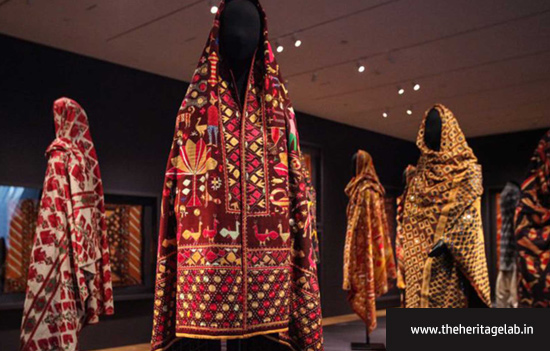
Credits.
Good blog to read
and here
Types of Phulkari
Thirma:
Symbol of purity, worn by elder women and widows, but at times, the choice of
white is made for esthetical reasons.
Darshan
Dwar: Made for a temple as an offering to thank God after a wish is fulfilled.
Bawan Bagh: Mosaic of fifty two different patterns which decorate the piece and is the rarest of all.
Varida Bagh: Made on an orange reddish khaddar with the main pattern being a group of three four small concentric lozenges (diamond) of growing size.
Chope:
Embroidered with one color, usually on the borders.
Suraj
Mukhi: Sunflower refers to the main pattern of this Phulkari.
Kaudi
Bagh: Chains of small white squares representing stylized cowries.
Panchranga:
Decorated with chevrons of five different colours.
Satranga:
Decorated with chevrons of seven different colours.
Meenakari:
Made of gold and white coloured pat, is decorated with small multi-coloured
lozenges referring to enamel work (meenakari).
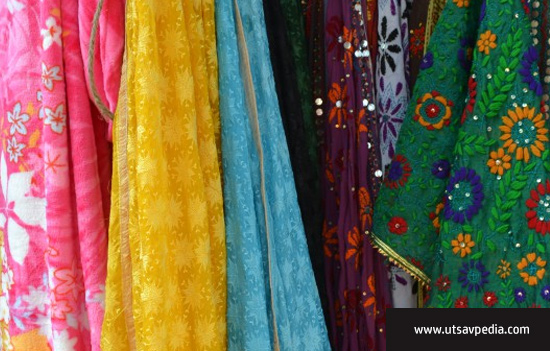
Credits. Good
blog to read
The Khes of Punjab
For
generations, women residing in the villages of Punjab have woven the khes as a
part of the trousseau that they take to their future home. With bold, harmonic
and imaginative colour patterns, it is also used as a coverlet while sleeping.
Khes
is a floor spread and bed covering that is traditionally made of cotton. The
thinner ones are used as bed coverings in winter and the thicker ones are used
in place of shawls during winters. It is a household craft and is mostly woven
by the women folk for their daughters, as an article to be gifted at time of
marriage.
According to historians, weaving is traditionally thought to have developed from mat making which have simple geometric patterns, sometimes braided and sometimes just coiled. Impressions of evidently similar coiled mats are found on the bases of pottery vessels from the Indus sites as early as Neolithic times. These recurring designs give fresh evidence of the remarkable survival of cultural patterns in Punjab. Khes evolved centuries ago during the Mughal period to meet the demand for a cotton blanket.
Before
the import of machine-made goods from Britain and Europe in the mid nineteenth
century, small scale cotton industries in Gambat, Hala, Nasarpur, Thatta and
Karachi, all in modern-day Pakistan, were known for their hand looms. Hand
spinning was practiced and the thicker phulkari fabrics, khes are living
examples of it. The most popular colours are deep yellow, red, black, blue and
green (white being regarded as neutral).
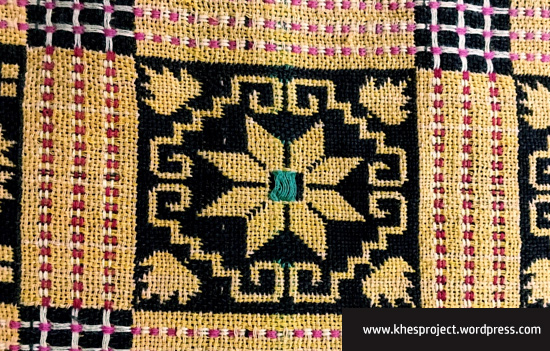
Credits
Costumes of Punjab
Men
Costumes
of Punjab are indicative of the dazzling and vibrant culture and lifestyle of
the people of the region. They are an amalgamation of colours, comfort and
beauty.
The Punjabi Pagg, Pagdi or Turban
It
is covered under article Turbans
of India
Kurta Payjama
Kurta-Pajama,
consisting of two pieces of garments, is one of the basic clothing of the
Punjabi men. The first garment is a kurta that is like a loose long shirt
almost reaching the knees, whereas the second one is the pajama or pyjama,
which is a lightweight drawstring trouser. It is similar to a shirt but with
long sleeves and no opening in the front. The kurta is worn by pulling it over
the head like a banyan or top vest. The Pyjamas are loose, baggy pants which
are tied at the waist. Some men also wear the Kurta with the Lungi or Tehmat,
which is a kind of sarong. During winters they can be seen wearing bright
colourful sweaters.
The Jama – The Flared Up Piece of Cloth
The
Jama is a long piece was worn by the men in the Punjab region during the Mughal
period. Tight from the torso flaring up like a skirt at the ankle or the knees,
it is worn with a turban on the head reflecting royalty and the majestic nature
of the kings. It was originally a dress for men but was also worn by women with
a tight-fitting pyjama. Characterised by the long sleeves and tied under the
armpits, it allows freedom of movement, making it another comfortable
traditional attire of Punjab.
Tehmat
Tamba
or Tehmat is a Punjabi style lungi with folds at the front. It is
typically worn by men Bhangra dancers with a kurta. This is one of the
dance costumes of Punjab. It is colourful.

Credits
Jutti
The
traditional dress of Punjabi men includes the traditional shoes called Jutti. It
is commonly made of leather with a lot of embroideries, in silver and gold
threads. These days, you can find Jutti in rubber soles as well. It is a type
of handcrafted footwear typically associated with Punjabis. The juttis have no
left-foot or right foot distinction and take the shape of the feet over a
period of time.
The jutti of a man differs from that worn by women in its design. The one worn by men come with an extended curve at the tip of the foot. Women’s juttis have extensive embellishments and embroidery.
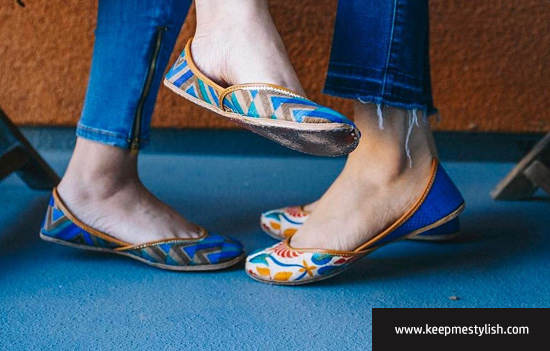
Credits
Women
Salwar Kameez
Women
and girls too dress in salwar kameez of fresh and bright colors, accompanied by
attractive and silky duppattas. Their salwar kameez has two pieces i.e. top
piece or shirt kameez and salwaar. The duppatta, which they wear over the
salwar kameez is majorly a shining fabric which females mostly wear over their
shoulders and over the head.
Ghagra
One of the few traditional dresses that has been modernised is the Punjabi ghagra which is a part of a four-piece outfit that originated in Punjab but is now worn in Haryana and parts of Himachal Pradesh. This attire is mostly donned during ‘Giddha’ a famous folk dance of Punjab performed by women to twirl around in mesmeric colours while singing folk songs reminiscent of its culture.
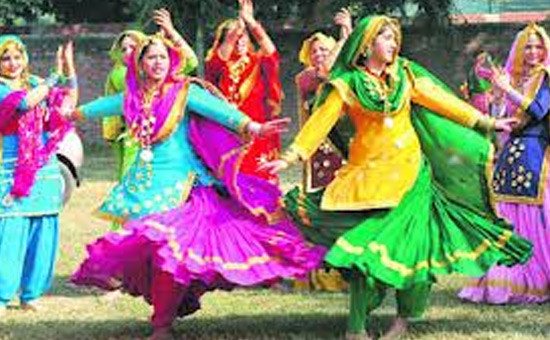 Gidda dance.
Gidda dance.
To see short video on
different designs of Ghagra
Parandi – The braided accessory
Parandi
or Paranda is a hair accessory which is bedecked with jewellery and colourful
threads used by women. It is also a form of affection when a bride receives it
from her husband. Earlier in Punjab, women wore Paranda to enhance their
traditional beauty and make their hair longer in the simplest way possible by
intricately weaving the threads together.
To
see Parandi
Patiala Salwar - Furled up Beauty - Traditional Dress of Punjab
This baggy and pleated trouser has its roots in the city of Patiala and was initially donned by men but later became a part of women's attire as well. It is usually combined with a Kurti and a chunni for women with a draping pattern at the back.
It
has evolved to include modern designs but still keeps in touch with the
tradition it was introduced with. It is one of the easiest and comfortable
dresses worn by the Punjabi women.
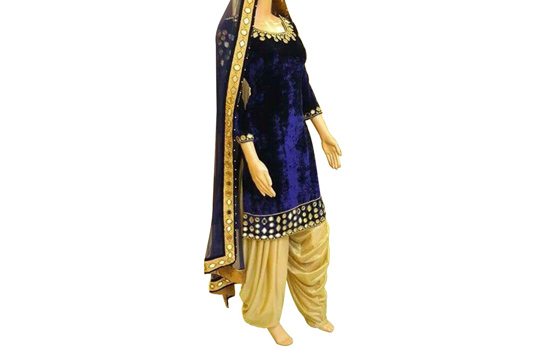 Patiala Salwar
Patiala Salwar
To see pictures
of all Costumes described above and good blog
Traditional Dresses of Haryana
What
Men Wear
Dhoti
The Haryanvi men wear 'dhoti' for trousers. Dhoti is a long piece of rectangular cloth, which is wrapped around the waist and legs and tucked in from the centre of the waistline. The loose ends are tucked in from the behind for a better fit. The men of Haryana wear white coloured dhoti and kurta. Different communities wear dhotis differently, as is the case with turbans across states.
Kurta or shirt
The
men wear a kurta or a shirt over their torsos. The kurta or shirts are usually
white in colour.
Pagri
Pagris
is a turban or a headgear for the men. It is a rolled piece of long cloth
wrapped around the head. Although, now fully stitched pagris are available
which make wearing a pagdi just like one is wearing a hat. Now days, only the
older men are found wearing pagris.
Juttis
The
traditional footwear of Haryana is jutti. Juttis are an Indian style
footwear and are similar to mojaris. Juttis are closed shoes only till front
half of the feet and thus are easy to wear. In North India, Juttis are made out
of leather with various designs on them. Juttis made out of jute are famous.
Blanket
Occasionally,
men are found with a blanket draped over one of their shoulder, especially
during winters. The blankets are light weighted. Most common type of blanket is
the dark coloured chequered one.
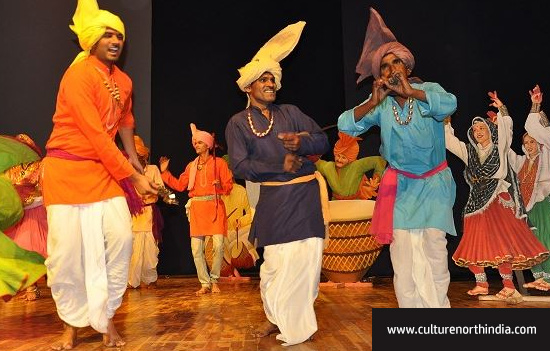 Haryana Men dress.
Haryana Men dress.
What
Women Wear
Shirt
Women
wear long sleeved shirts or kurtas made out of cotton.
Ghagra (Daaman)
Women
wear long, free, flared skirts called ghagra. Ghaghras have different patterns
and designs on them and are of many bright colours. They may also have a border
at the bottom end.
Odhni
Odhni
or chunder is an elongated piece of cloth that women wear over their attire.
The chunders have colourful borders with different patterns. Women use one end
of the chunder to cover their heads. The other end is tucked into their
waistline spreading right onto the front.
Petticoat
Lehenga/Petticoats
are straight fitted long skirts. They are different from ghaghras as ghagra are
far free flowing and open.
Angia
Angia
is a tight-fitting blouse that women were to cover their torsos. The blouses
come only till midway on the torso.
Odhni
Women
use odhni or dupatta over their attire.
Shoes
Women
of Haryana wear traditional Indian style of footwear just as the men do. The
traditional footwear is called jutti and is worn by most communities in North
India.
Women of these communities work outside in the fields, especially during
harvest season. Thus, these dresses are designed in a manner that makes it comfortable
for them to wear.
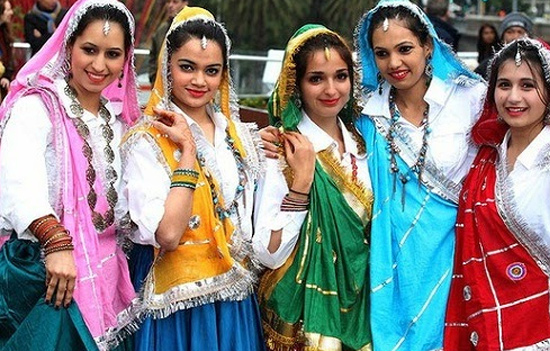 Haryana Women dress.
Haryana Women dress.
Good read
on Traditional dresses of Haryana
Reference and Here
The
purpose of this compilation is to document and promote. We have given credits
and reference links in this compilation along with third party links (to
promote). In case some are missed, it is not with malafide intent. Please
email full details to esamskriti108@gmail.com
and we shall effect the change.
To read all
articles by author
To
read all articles on Traditional Textiles of India
Author Trishna
Patnaik
is a self-taught artist based in Mumbai, Trishna has been practising art for over 14 years. She is now a full-time professional painter pursuing her passion to create and explore to the fullest. She conducts painting workshops across India. She is also an art therapist and healer who works with clients on a one to one basis. Not to forget her quality writings on Indian Art and now Textiles for esamskriti. She fancies the art of creative writing.
Also read Art, Music, Dance and Textile Traditions of Punjab